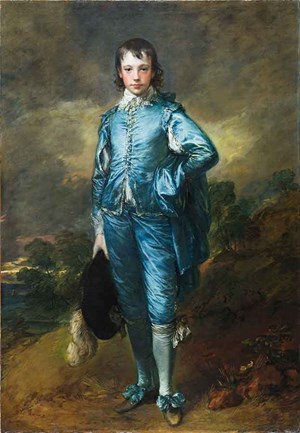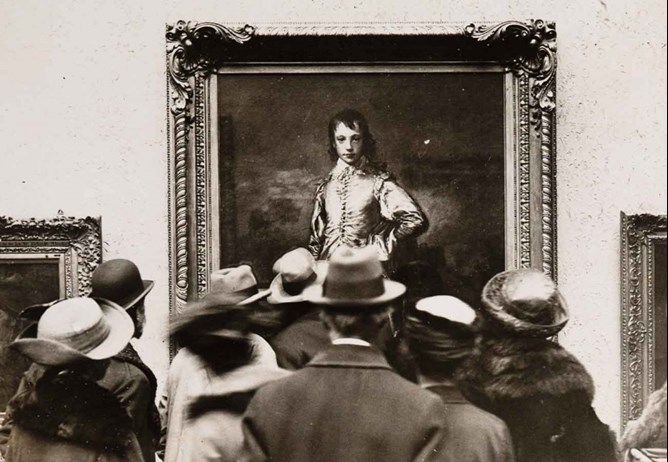
One hundred years after Henry E. Huntington purchased Thomas Gainsborough’s masterpiece, The Blue Boy (ca. 1770) from the Duke of Westminster, and it set sail from England for its new home in the United States, the iconic portrait will go back on view at the National Gallery in London.
One hundred years after Henry E. Huntington purchased Thomas Gainsborough’s masterpiece, The Blue Boy (ca. 1770) from the Duke of Westminster, and it set sail from England for its new home in the United States, the iconic portrait will go back on view at the National Gallery in London. The free exhibition will run from Jan. 25 through May 3, 2022, its opening date marking to the day 100 years since it last hung on the walls there. This will be the first time that The Huntington Library, Art Museum, and Botanical Gardens has loaned the painting.
At the National Gallery, The Blue Boy will be displayed among a small selection of related masterworks that connect to Gainsborough’s oeuvre and influences. A robust slate of public programs and a catalog will complement the exhibition. In exchange for the loan, a work from the National Gallery’s collection will come to The Huntington for display.
 Installation view in the Thornton Portrait Gallery at The Huntington. Left to right: Joshua Reynolds, Diana (Sackville), Viscountess Crosbie, 1777; Thomas Gainsborough, The Blue Boy, 1770; Thomas Gainsborough, Elizabeth (Jenks) Beaufoy, later Elizabeth Pycroft, ca. 1780.
Installation view in the Thornton Portrait Gallery at The Huntington. Left to right: Joshua Reynolds, Diana (Sackville), Viscountess Crosbie, 1777; Thomas Gainsborough, The Blue Boy, 1770; Thomas Gainsborough, Elizabeth (Jenks) Beaufoy, later Elizabeth Pycroft, ca. 1780.
“This masterpiece has made an indelible mark on both art history and popular culture, capturing the imaginations of a wide range of audiences,” said Karen R. Lawrence, Huntington President. “Given The Blue Boy’s iconic status at The Huntington, this is an unprecedented loan, one which we considered very carefully. We hope that this partnership with the National Gallery will spark new conversations, appreciation, and research on both sides of the Atlantic.”
A part of the core art collection built by Huntington and his wife Arabella, The Blue Boy has been a visitor favorite since it went on view when The Huntington opened to the public in 1928. “We imagine this to be the one and only time the painting will travel, given its iconic status at The Huntington,” Lawrence said.
The loan follows The Huntington’s “Project Blue Boy,” an extensive, nearly three-year conservation project to analyze, stabilize, clean, and restore the dramatic large-scale painting. Much of the conservation work was performed in public to provide visitors with a real-time window into the art and science of the conservation practice.
During the conservation process, curators were able to see for themselves a legendary note on the back of the painting. Before leaving England in 1922, The Blue Boy went on display for three weeks at the National Gallery, attracting some 90,000 visitors. A 1922 New York Times story about the painting’s departure reported, “The Blue Boy is leaving England forever and 90,000 persons seized a last opportunity to see it... On one of the stretchers at the back (of the painting) is scribbled in pencil, ‘Au revoir. CH.’ It is the wish of Sir Charles Holmes, director of the National Gallery, which neither he nor any other Englishman expects to see fulfilled.”
That wish, to see The Blue Boy again—albeit some generations later—will come true.
“The Blue Boy has held a place in the hearts of the British public since it was first exhibited at the Royal Academy in 1770,” said National Gallery Director Gabriele Finaldi. “We will be delighted to bring this extraordinary work of 18th-century British painting to the people of Great Britain once again.”
About The Blue Boy
Thomas Gainsborough (1727–1788) was among the most prominent artists of his day. Though he preferred to paint landscapes, he made his career producing stylish portraits of the British gentry and aristocracy. Jonathan Buttall (1752–1805), the first owner of The Blue Boy, was once thought to have been the portrait’s sitter, but recent research has disproven this identification. The identity of the subject remains unconfirmed, though it has been suggested that the boy’s features are those of Gainsborough’s nephew and studio assistant, Gainsborough Dupont (1754–1797). The figure’s costume is significant. Instead of dressing his model in the elegant finery worn by most sitters at the time, or in the kind of quasi-classical robes often employed by his rival Joshua Reynolds, Gainsborough chose knee breeches and a slashed doublet with a lace collar–-a nod to the work of Anthony van Dyck, the 17th-century Flemish painter who had profoundly influenced British art.
 The Blue Boy on display at the National Gallery, London, 1922. The Huntington Library, Art Museum, and Botanical Gardens.
The Blue Boy on display at the National Gallery, London, 1922. The Huntington Library, Art Museum, and Botanical Gardens.
The painting first appeared in public in the Royal Academy exhibition of 1770 as A Portrait of a Young Gentleman, where it received high acclaim, and by 1798, it was being called “The Blue Boy”—a nickname that stuck.
Henry E. (1850–1927) and Arabella (1851–1924) Huntington purchased The Blue Boy from the Duke of Westminster in 1921. It was included in a number of exhibitions in the 19th century and was reproduced many times for commercial purposes. By the time the Huntingtons bought it, it was one of the most famous artworks in England. During its journey from London to Los Angeles, The Blue Boy caused a sensation in the United States, as it was the focus of a series of limited-engagement exhibitions engineered by art dealer Joseph Duveen.
Fashion historian Kimberly Chrisman-Campbell, writing in 2017 in The Atlantic, says contemporary artist Kehinde Wiley isn’t the only creative who’s been inspired by The Blue Boy. “The Pop Art pioneer Robert Rauschenberg credited The Blue Boy with inspiring him to become a painter after he visited The Huntington on shore leave from the Navy during World War II. More recently, the LA artist Alex Israel evoked it in his 2014 self-portrait in a blue satin Dodgers jacket. Quentin Tarantino paid tribute to a now-lost silent movie about the painting—F. W. Murnau’s 1919 Der Knabe in Blau—by putting Jamie Foxx in a frilly blue suit in Django Unchained.”
Beyond its cultural significance, the painting is considered a masterpiece of artistic virtuosity. Gainsborough's command of color and mastery of brushwork are on full display in the painting, made even more apparent as a result of recent conservation work.

ArtDependence Magazine is an international magazine covering all spheres of contemporary art, as well as modern and classical art.
ArtDependence features the latest art news, highlighting interviews with today’s most influential artists, galleries, curators, collectors, fair directors and individuals at the axis of the arts.
The magazine also covers series of articles and reviews on critical art events, new publications and other foremost happenings in the art world.
If you would like to submit events or editorial content to ArtDependence Magazine, please feel free to reach the magazine via the contact page.